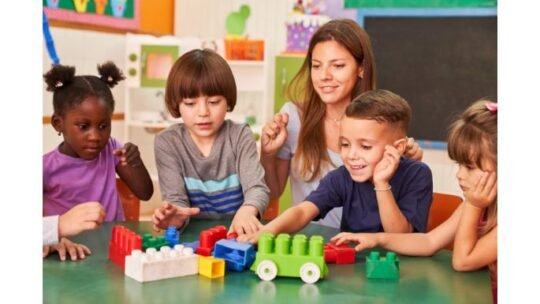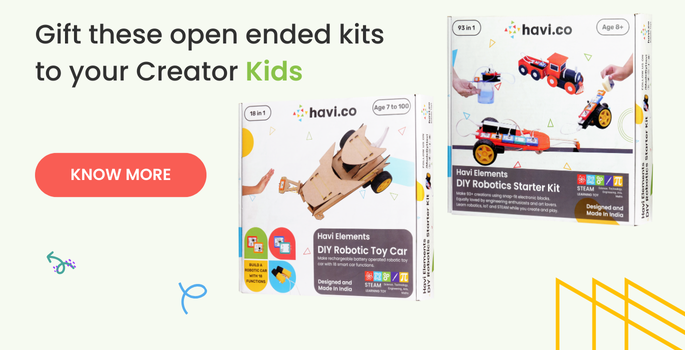Importance of open ended toys for school aged and teen children


Do your 9-year-old and 13-year-old play with toys? Don’t feel awkward. Playing with open-ended toys for school-age & teenage helps them learn better and build a successful career. Read on.
This fact is no more an invention that children of age less than 8, have the highest number of neuron connections in their brain and have the highest learning capabilities, provided they do it the right way.
Though several early childhood experts, from madam Montessori to Gijubhai Badheka have designed their educational practices around this, it later got validation from scientific research. Child experts, parents & teachers have been trying to tap this golden period now.
One extremely useful tool being used for this is open-ended toys.
Yes, it can be that doll set, doctor set, wooden blocks, a set of discs, a collection of animals, or anything. They inspire open-ended play. Play without boundaries, without instructions, without definition. And that’s the core of igniting imagination and creativity.
School aged children and teenagers are occupied mostly with academic learning and the time spent on open-ended play goes down drastically, tends to zero sometime, seriously!
This kills the imagination and creativity and pushes them into a trap of learning only to prepare for exams.
In the new age of occupation, that adversely affects careers too.
And that’s why it’s important we discuss this topic of open-ended toys for ages 7, age 8, 9, age 10 onwards, and teenagers too.
What does an open-ended toy mean?
Open-ended toys are those toys that do not come with a specific way to play with them. They don’t need detailed instructions. The user needs to be creative and find ways to play with it.
Several times it happens that the child will play with it in a way even the designers of that toy would not have anticipated. And it’s common.
Do we need teaching and instructions about what to make with the sand on the beach? Castles, temples, houses, dams, and so many things would have been formed with the same sand.
That’s what open-ended toys and open-ended play are!
What is not open-ended (toy)?
Anything which can be used in a specific and defined way is not open-ended. Neither the binoculars nor companion robots.
No, not even the DIY kits in which we assemble the parts as per the instructions provided and prepare the final output. Yes, those are useful to improve engineering or execution skills, but they are not open-ended. You can’t do beyond the specifications. And these are called close-ended.
Remember that they are not bad, we are just spotting the difference between the two.
And that way the learning system we are into is completely close-ended. You need to read specific things and recite them in a very specific way. Write it down the way someone wants it to be and once done, no one cares.
With that last statement, I can’t better convince with the topic of this blog post.
Benefits of open-ended toys
1. Keeps imagination alive
The child is born imaginative. And that’s why it can keep trying to put a bigger block into a smaller plate for hours. It’s not ignorance, it’s imagination. So please, don’t try to help her!
Playing, creating, and staying engaged with open-ended toys keeps your imagination alive. You can build a house and a horse out of the same set of blocks! That’s amazing, no!
2. Boosts creativity
During an expo somewhere in past, an ice cream vendor ran out of plates and he had to shut the shop for that reason. The neighborhood vendor, making waffles, saw the opportunity and made waffle cones to serve the ice cream without plates. And that’s how the ice cream cones were born.
Such wonderful stories are rooted in creativity. And when you are creating with open-ended toys, you might be sawing something valuable for the future. Because you are improving your creativity.
Apart from these two major benefits, depending on the kind of open-ended toys, they help build and improve the following skills:
- Problem-solving ability
- STEAM skills (STEAM = Science, Technology, Engineering, Arts, Maths)
- Execution ability
- Curiosity
- Meaningful investment of time
- Entrepreneurial skills
Examples of open-ended toys
Costumes, kitchen sets, doctor sets, and animal figures are good open-ended toys for preschoolers. But what open-ended toys are suitable for children of age 7, 8, 9, and beyond and teenagers too? Let’s check that.
1. Blocks

Havi elements for example can be used to create electronic creations. When we designed the product, we figured out 93 different creations and applications which can be made using Havi Elements. But now as the product is in the market, the users have found far more problems that can be solved and creations that can be made using Havi Elements. That’s all due to their imagination and creativity.
Havi Elements serves multiple purposes. Keeps imagination and creativity alive. Makes them learn the subjects they should learn (STEAM = Science, Technology, Engineering, Arts and Maths). Keeps them engaged in the creation process and brings active learning.
Papers, cardboard, strings, cutters, glues, skewers, ice cream sticks, and toothpicks. For some, it’s a storage issue and for others, it’s the magic material using which they can shape their dreams into reality.
Allowing school-aged children and teenagers to create at least one boundary-less project a month using craft material, keeps them fresh, engaged, and creative for everything else.
3. Colors and canvas

- 9 out of 12 agreed they are getting relaxed after doing the activity and started feeling better at work.
- 5 out of 12 were amazed at their drawing skills and mentioned that they have never thought they can use the brush.
Same is the case with school-aged and teenage children. Brushing on plain canvas brings imagination and creativity alive.
4. Clays
That play-dough, slime, pottery clay, or beach sand. Clay helps do and creates something useful.
Now it’s your turn. Let your school-aged, and teenagers spend time with these open-ended toys and see the difference in their studies, behavior, and mood.
Send your questions, concerns, and feedback to us. Even a couple of words of appreciation will suffice.

